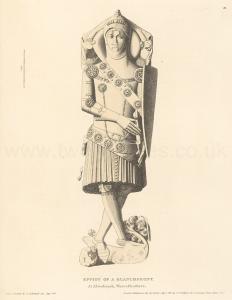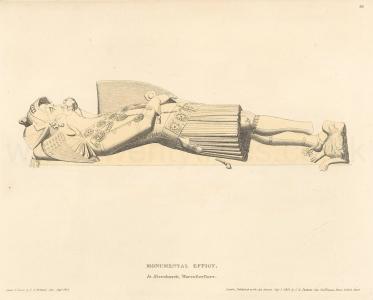Effigy of a Blanchfront
Effigy of a Blanchfront is in Monumental Effigies of Great Britain.
In Alvechurch, Worcestershire [Map]. This figure is termed by Nash "a knight of the holy voyage adopting the very probable conjecture, that the crossed legs indicated a vow of pilgrimage to the Holy Land. The inhabitants of the neighbourhood call it the Knight of the Green, who they say resided on Wetherock-hill; where they still show the site of his moated house.
A grant is extant, of the time of Edward the Third, of certain lands in the tenure of Thomas Kempe and John Kempe, to Thomas Blanchfront. Sir John Blanchfront, his descendant, is mentioned in an instrument A. D. 1346, the 21st of the reign of Edward the Third. This personage, therefore, the effigy may be conjectured to represent.
As a specimen of an elegant variety of the costume of a knight in the fourteenth century, the beautiful and spirited etching before us possesses great interest. The basinet assumes the form of the double curved gothic arch, and the heavy close helmet of the tourney is supplied by the aventaille, or ventaille, attached to the basinet, and thrown back to show the face; roundels, tastefully filled up with roses, are affixed to the armour at the shoulders, the elbows, and on the belt. From each of the two roundels on the paps descends a chain, fastening the handle of the sword. The lower part of the surcoat is gathered into numerous folds, and is closed in the front by a row of studs or buttons. Plate No. 2 exhibits the profile of the figure, the lacing of the surcoat clearly and sharply defined. The rowel of one of the spurs, a rare exception, is fortunately unbroken.

